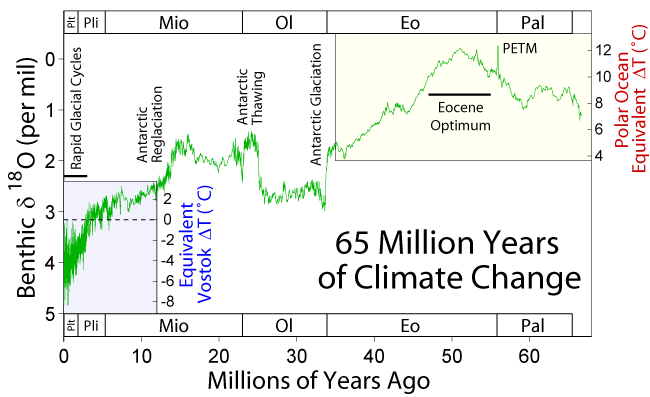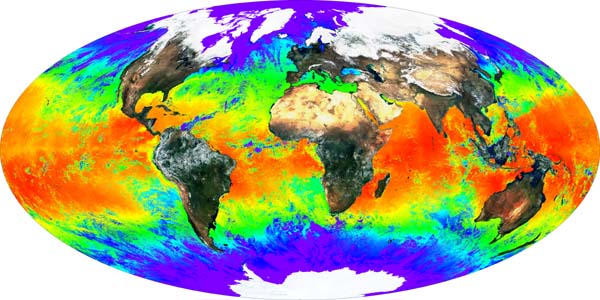After four fascinating instalments in the known unknowns series we have (sadly) come to the final post. Since the series began in September we have explored the top questions that still remain unanswered when it comes to understanding the inner workings of the planet as well as how the interplay of a number of systems that occur at the Earth’s surface give rise to its varied landscapes. The series would not be complete without assessing the open questions on how climate and life have contributed to shape the planet and so it seems fitting that we should end the series with this topic. The geological record shows that climate is relatively stable over tectonic time-scales whereas it undergoes abrupt changes in periods ranging from decades to hundreds of thousand years. Past periods when the planet underwent extreme climate conditions may help to understand the mechanisms behind that behaviour and its significance for the evolution of the Solid Earth and for the current climate change challenge. However, we are still a long way from having all the answers…

Image Source: Wikimediacommons; Image credit: Robert A. Rohde published as part of the Global Warming Art project)
- What caused the largest carbon isotope changes in Earth? (Grotzinger et al., Nat. Geosc, 2011) How does Earth’s climate respond to elevated levels of atmospheric CO2?
- Was there ever a snow-ball Earth during the earliest stages of Life on Earth?
- Were there also rivers and lakes on Mars? (Hand,Nature, 2012) Were there large outburst floods similar to those on Earth?
- What were the causes and what shaped the recovery from mass extinctions as those at the K-T boundary, the Permian-Triassic or the Late Triassic? Massive volcanism? Meteorites? Microbes? Some recent papers: (Rampino & Kaiho, Geology, 2012; Lindström et al., Geology, 2012; Chen & Benton, Nat. GeoSci, 2012; Rothman et al.,PNAS, 2014).
- What triggered the extreme climatic variability during the Quaternary and the roughly coeval acceleration in continental erosion and sediment delivery to the margins? [Peizhen, Molnar et al., Nature, 2001; Herman et al., Nature, 2013) Was this related to the tectonic closure of the Central American Seaway? How do these climate events translate quantitatively into sea level changes?
- How do climate changes translate quantitatively into sea level changes? How do ice sheets and sea level respond to a warming climate? What controls regional patterns of precipitation, such as those associated with monsoons or El Niño?
- What caused the Quaternary extinction(s)? Human expansion? Climate Change? How sensitive are ecosystems and biodiversity to environmental change? Was the large fauna extinction ~13,000 yr ago a result of the Younger Dryas climatic event? Was this caused by an extraterrestrial impact? (see this article and this other article) Or may it be linked to the outburst of Lake Agassiz?
- How relevant are subsurface microorganisms to earth dynamics by controlling soil formation and the methane cycle? What are the origin, composition, and global significance of deep subseafloor communities? What are the limits of life in the subseafloor realm?
- The atmosphere is shaped by the presence of life, a powerful chemical force. The Earth’s evolution has seems to affect the evolution of life (see the Cambrian explosion of animal life, for instance; plus this recent paper on that). To what extent? And how much control has life on climate? (another recent paper). Is it possible to quantify these links to make reliable predictions that allow filling the data gaps or assessing the chances for extraterrestrial life?
- How much of the present climate change is anthropogenic and how much is natural? How will growing emissions from a growing global population with a growing consumption impact on climate? Computer models are in need of well documented extreme scenarios from the geological past to be properly calibrated and make reliable predictions in this field.
The 49 questions covered in this series address very specific problems and unresolved problems but there are broader difficulties that limit our understanding of how the planet works.
Not for the first time, we must acknowledge that technology continues to limit direct observation of process that might clarify the source of complex geological phenomena. For example, many processes including plate tectonics are known to be driven by the nature of the materials that make up the planet interiors, down to the smallest atomic scales, as thought for instance for the trigger of earthquakes. Answers may arrive via new devices and analytical tools working at the high pressures and temperatures of Earth’s interior.
Another issue is that of reconciling time scales. We can only make observations in the present, whilst the phenomena we try to understand occur in time scales with very different orders of magnitude. We are also limited by having to convincingly scale rates of lab experiments (e.g., mineral physics), and/or analogue models to corresponding geological scenarios. Not unreasonably, this approach does not always yield satisfactory/reliable outcomes.

Global Surface Reflectance and Sea Surface Temperature (Credit: MODIS Instrument Team, NASA Goddard Space Flight Cente).
Implementing Episodicity in Gradualism: For historical reasons, geology has generally underestimated the role of episodicity in nature. However, there is a growing interest driven to exceptional events and to the stochasticity of Earth’s subsystems. An example for this is the preeminence of extreme flooding events (larger than average) in erosion and surface sediment transport and during the evolution of landscape, and the importance of upscaling flood stochasticity into sediment transport models (eg., Lague, JGR, 2010). Even plate tectonics may have been episodic (during the Archean at least, (Moyen & van Hunen, Geology, 2011). 4D hyperscale data sets in geomorphology are increasingly showing the limits of smooth-process approaches. Future understanding of the Earth will benefit from incorporating the full frequency spectrum (the episodicity) in modeling natural phenomena, rather than systematically approaching these as gradual processes.
Finally, whilst computer models help us understand whether the complexity of nature can be explained by the interplay between simple processes, can we further model the Earth as a complex system of complex systems? And when can we expect ‘compact’ explanations?
With these last broad considerations we close the known inknowns series. Hopefully, it has achieved what it set out to do: provide an overview of what earth scientists are up to and what the hot topics and questions in Earth sciences are. Understanding these will lead us ever closer to understand phenomena that are fundamental to societal needs such as mineral resources, global change, or waste disposal.
By Laura Roberts Artal, EGU Communications Officer, based on the article previously posted on RetosTerricolas by Daniel Garcia-Castellanos, researcher at ICTJA–CSIC, Barcelona
